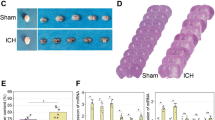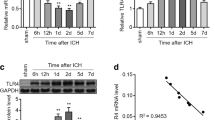Abstract
Spontaneous intracerebral hemorrhage (ICH) is a clinical challenge with high disability and lacks an effective treatment. miR-29a strongly expressed in the brain has been implicated in various neurological disorders. In this study, we investigated the biological roles of miR-29a in axonal outgrowth and neurological outcomes after ICH and relevant molecular mechanism. The rat model of ICH was established by injection of autologous whole blood into the right basal ganglia. First, a significant decrease in miR-29a level was found in perihematomal brain tissues and cerebrospinal fluid (CSF) after ICH in vivo and hemin-treated neurons in vitro. Further study documented that lentivirus-mediated miR-29a overexpression could remarkably attenuate hemorrhagic brain injury, promoted regenerative outgrowth of injured axons and improved neurobehavioral and cognitive impairments after ICH in rats. In addition, we also identified that overexpression of miR-29a obviously alleviated neuronal damage and mitochondrial dysfunctions, and facilitated neurite outgrowth in cultured neurons exposed to hemin in vitro. Furthermore, luciferase reporter assay showed that miR-29a directly targeted the 3′-UTR region of phosphatase and tensin homolog (PTEN) mRNA and negatively regulated its expression. More importantly, pharmacological inhibition of PTEN has similar neuroprotective effects as miR-29a overexpression involving activation of the PI3K/Akt pathway after hemorrhagic stroke. Collectively, these results suggested that elevated miR-29a could contribute to axonal outgrowth and neurological recovery through targeting PTEN/PI3K/Akt pathway after ICH, thereby providing a potential therapeutic target for patients with ICH.








Similar content being viewed by others
References
Aronowski J, Zhao X (2011) Molecular pathophysiology of cerebral hemorrhage: secondary brain injury. Stroke 42(6):1781–1786. https://doi.org/10.1161/strokeaha.110.596718
Benedictus MR, Hochart A, Rossi C, Boulouis G, Henon H, van der Flier WM, Cordonnier C (2015) Prognostic factors for cognitive decline after intracerebral hemorrhage. Stroke 46(10):2773–2778. https://doi.org/10.1161/strokeaha.115.010200
Berry M, Ahmed Z, Morgan-Warren P, Fulton D, Logan A (2016) Prospects for mTOR-mediated functional repair after central nervous system trauma. Neurobiol Dis 85:99–110. https://doi.org/10.1016/j.nbd.2015.10.002
Chang N, El-Hayek YH, Gomez E, Wan Q (2007) Phosphatase PTEN in neuronal injury and brain disorders. Trends Neurosci 30(11):581–586. https://doi.org/10.1016/j.tins.2007.08.006
Chen W, Xia M, Guo C, Jia Z, Wang J, Li C, Li M, Tang X, Hu R, Chen Y, Liu X, Feng H (2019a) Modified behavioural tests to detect white matter injury-induced motor deficits after intracerebral haemorrhage in mice. Sci Rep 9(1):16958. https://doi.org/10.1038/s41598-019-53263-6
Chen Z, Xu N, Dai X, Zhao C, Wu X, Shankar S, Huang H, Wang Z (2019b) Interleukin-33 reduces neuronal damage and white matter injury via selective microglia M2 polarization after intracerebral hemorrhage in rats. Brain Res Bull 150:127–135. https://doi.org/10.1016/j.brainresbull.2019.05.016
Christie KJ, Webber CA, Martinez JA, Singh B, Zochodne DW (2010) PTEN inhibition to facilitate intrinsic regenerative outgrowth of adult peripheral axons. J Neurosci 30(27):9306–9315. https://doi.org/10.1523/jneurosci.6271-09.2010
Chu X, Wu X, Feng H, Zhao H, Tan Y, Wang L, Ran H, Yi L, Peng Y, Tong H, Liu R, Bai W, Shi H, Li L, Huo D (2018) Coupling between interleukin-1R1 and necrosome complex involves in hemin-induced neuronal necroptosis after intracranial hemorrhage. Stroke 49(10):2473–2482. https://doi.org/10.1161/strokeaha.117.019253
Cui C, Cui Y, Gao J, Li R, Jiang X, Tian Y, Wang K, Cui J (2017) Intraparenchymal treatment with bone marrow mesenchymal stem cell-conditioned medium exerts neuroprotection following intracerebral hemorrhage. Mol Med Rep 15(4):2374–2382. https://doi.org/10.3892/mmr.2017.6223
Diaz NF, Cruz-Resendiz MS, Flores-Herrera H, Garcia-Lopez G, Molina-Hernandez A (2014) MicroRNAs in central nervous system development. Rev Neurosci 25(5):675–686. https://doi.org/10.1515/revneuro-2014-0014
Faravelli I, Corti S (2018) MicroRNA-directed neuronal reprogramming as a therapeutic strategy for neurological diseases. Mol Neurobiol 55(5):4428–4436. https://doi.org/10.1007/s12035-017-0671-7
Han X, Zhao X, Lan X, Li Q, Gao Y, Liu X, Wan J, Yang Z, Chen X, Zang W, Guo AM, Falck JR, Koehler RC, Wang J (2019) 20-HETE synthesis inhibition promotes cerebral protection after intracerebral hemorrhage without inhibiting angiogenesis. J Cereb Blood Flow Metab 39(8):1531–1543. https://doi.org/10.1177/0271678x18762645
Knafo S, Esteban JA (2017) PTEN: local and global modulation of neuronal function in health and disease. Trends Neurosci 40(2):83–91. https://doi.org/10.1016/j.tins.2016.11.008
Leclerc JL, Santiago-Moreno J, Dang A, Lampert AS, Cruz PE, Rosario AM, Golde TE, Dore S (2018) Increased brain hemopexin levels improve outcomes after intracerebral hemorrhage. J Cereb Blood Flow Metab 38(6):1032–1046. https://doi.org/10.1177/0271678x16679170
Lee YR, Chen M, Pandolfi PP (2018) The functions and regulation of the PTEN tumour suppressor: new modes and prospects. Nat Rev Mol Cell Biol 19(9):547–562. https://doi.org/10.1038/s41580-018-0015-0
Li H, Mao S, Wang H, Zen K, Zhang C, Li L (2014) MicroRNA-29a modulates axon branching by targeting doublecortin in primary neurons. Protein Cell 5(2):160–169. https://doi.org/10.1007/s13238-014-0022-7
Li M, Xia M, Chen W, Wang J, Yin Y, Guo C, Li C, Tang X, Zhao H, Tan Q, Chen Y, Jia Z, Liu X, Feng H (2020) Lithium treatment mitigates white matter injury after intracerebral hemorrhage through brain-derived neurotrophic factor signaling in mice. Transl Res 217:61–74. https://doi.org/10.1016/j.trsl.2019.12.006
Lin W, Li M, Li Y, Sun X, Li X, Yang F, Huang Y, Wang X (2014) Bone marrow stromal cells promote neurite outgrowth of spinal motor neurons by means of neurotrophic factors in vitro. Neurol Sci 35(3):449–457. https://doi.org/10.1007/s10072-013-1490-x
Liu Y, Lu G, Su XW, Ding T, Wang WL, Li YM, Poon WS, Ao LJ (2018) Characterization of axon damage, neurological deficits, and histopathology in two experimental models of intracerebral hemorrhage. Front Neurosci 12:928. https://doi.org/10.3389/fnins.2018.00928
Liu Y, Ma C, Li H, Shen H, Li X, Fu X, Wu J, Chen G (2019) Nogo-A/Pir-B/TrkB signaling pathway activation inhibits neuronal survival and axonal regeneration after experimental intracerebral hemorrhage in rats. J Mol Neurosci MN 69(3):360–370. https://doi.org/10.1007/s12031-019-01365-1
Ma R, Wang M, Gao S, Zhu L, Yu L, Hu D, Zhu L, Huang W, Zhang W, Deng J, Pan J, He H, Gao Z, Xu J, Han X (2020) miR-29a promotes the neurite outgrowth of rat neural stem cells by targeting extracellular matrix to repair brain injury. Stem Cells Dev. https://doi.org/10.1089/scd.2019.0174
Mahar M, Cavalli V (2018) Intrinsic mechanisms of neuronal axon regeneration. Nat Rev Neurosci 19(6):323–337. https://doi.org/10.1038/s41583-018-0001-8
Muller M, Jakel L, Bruinsma IB, Claassen JA, Kuiperij HB, Verbeek MM (2016) MicroRNA-29a is a candidate biomarker for Alzheimer’s disease in cell-free cerebrospinal fluid. Mol Neurobiol 53(5):2894–2899. https://doi.org/10.1007/s12035-015-9156-8
Ouyang YB, Xu L, Lu Y, Sun X, Yue S, Xiong XX, Giffard RG (2013) Astrocyte-enriched miR-29a targets PUMA and reduces neuronal vulnerability to forebrain ischemia. Glia 61(11):1784–1794. https://doi.org/10.1002/glia.22556
Papadopoulou AS, Serneels L, Achsel T, Mandemakers W, Callaerts-Vegh Z, Dooley J, Lau P, Ayoubi T, Radaelli E, Spinazzi M, Neumann M, Hebert SS, Silahtaroglu A, Liston A, D'Hooge R, Glatzel M, De Strooper B (2015) Deficiency of the miR-29a/b-1 cluster leads to ataxic features and cerebellar alterations in mice. Neurobiol Dis 73:275–288. https://doi.org/10.1016/j.nbd.2014.10.006
Singh B, Singh V, Krishnan A, Koshy K, Martinez JA, Cheng C, Almquist C, Zochodne DW (2014) Regeneration of diabetic axons is enhanced by selective knockdown of the PTEN gene. Brain 137(Pt 4):1051–1067. https://doi.org/10.1093/brain/awu031
Sun L, Zhao M, Zhang J, Lv M, Li Y, Yang X, Liu A, Wu Z (2017) MiR-29b downregulation induces phenotypic modulation of vascular smooth muscle cells: implication for intracranial aneurysm formation and progression to rupture. Cell Physiol Biochem 41(2):510–518. https://doi.org/10.1159/000456887
Tan C, Yu C, Song Z, Zou H, Xu X, Liu J (2017) Expression of MicroRNA-29a regulated by yes-associated protein modulates the neurite outgrowth in N2a cells. Biomed Res Int 2017:5251236. https://doi.org/10.1155/2017/5251236
Tao C, Hu X, Li H, You C (2017) White matter injury after intracerebral hemorrhage: pathophysiology and therapeutic strategies. Front Hum Neurosci 11:422. https://doi.org/10.3389/fnhum.2017.00422
van Asch CJ, Luitse MJ, Rinkel GJ, van der Tweel I, Algra A, Klijn CJ (2010) Incidence, case fatality, and functional outcome of intracerebral haemorrhage over time, according to age, sex, and ethnic origin: a systematic review and meta-analysis. Lancet Neurol 9(2):167–176. https://doi.org/10.1016/s1474-4422(09)70340-0
Volpicelli F, Speranza L, Pulcrano S, De Gregorio R, Crispino M, De Sanctis C, Leopoldo M, Lacivita E, di Porzio U, Bellenchi GC, Perrone-Capano C (2019) The microRNA-29a modulates serotonin 5-HT7 receptor expression and its effects on hippocampal neuronal morphology. Mol Neurobiol 56(12):8617–8627. https://doi.org/10.1007/s12035-019-01690-x
Wang KY, Wu CH, Zhou LY, Yan XH, Yang RL, Liao LM, Ge XM, Liao YS, Li SJ, Li HZ, Gao LL, Lin JS, Huang SY (2015) Ultrastructural changes of brain tissues surrounding hematomas after intracerebral hemorrhage. Eur Neurol 74(1–2):28–35. https://doi.org/10.1159/000434631
Wang WH, Wang YH, Zheng LL, Li XW, Hao F, Guo D (2016) MicroRNA-29a: a potential biomarker in the development of intracranial aneurysm. J Neurol Sci 364:84–89. https://doi.org/10.1016/j.jns.2016.03.010
Wu J, Sun L, Li H, Shen H, Zhai W, Yu Z, Chen G (2017) Roles of programmed death protein 1/programmed death-ligand 1 in secondary brain injury after intracerebral hemorrhage in rats: selective modulation of microglia polarization to anti-inflammatory phenotype. J Neuroinflammation 14(1):36. https://doi.org/10.1186/s12974-017-0790-0
Yin H, Shen L, Xu C, Liu J (2018) Lentivirus-mediated overexpression of miR-29a promotes axonal regeneration and functional recovery in experimental spinal cord injury via PI3K/Akt/mTOR pathway. Neurochem Res 43(11):2038–2046. https://doi.org/10.1007/s11064-018-2625-5
Zhang CY, Ren XM, Li HB, Wei W, Wang KX, Li YM, Hu JL, Li X (2019) Effect of miR-130a on neuronal injury in rats with intracranial hemorrhage through PTEN/PI3K/AKT signaling pathway. Eur Rev Med Pharmacol Sci 23(11):4890–4897. https://doi.org/10.26355/eurrev_201906_18077
Acknowledgements
The present study was supported by a grant from the Natural Science Foundation of Hebei Province (H2019105137).
Author information
Authors and Affiliations
Contributions
JC was responsible for experimental design and revised the paper. MZ performed the experiments and wrote the manuscript. JG, XJ and YT carried out the experiments and analyzed the data. XZ prepared the figures and tables. KW provided some technical supports.
Corresponding author
Ethics declarations
Conflict of interest
The authors declare no conflict of interest.
Additional information
Publisher's Note
Springer Nature remains neutral with regard to jurisdictional claims in published maps and institutional affiliations.
Rights and permissions
About this article
Cite this article
Zhao, M., Gao, J., Zhang, Y. et al. Elevated miR-29a Contributes to Axonal Outgrowth and Neurological Recovery After Intracerebral Hemorrhage via Targeting PTEN/PI3K/Akt Pathway. Cell Mol Neurobiol 41, 1759–1772 (2021). https://doi.org/10.1007/s10571-020-00945-9
Received:
Accepted:
Published:
Issue Date:
DOI: https://doi.org/10.1007/s10571-020-00945-9




